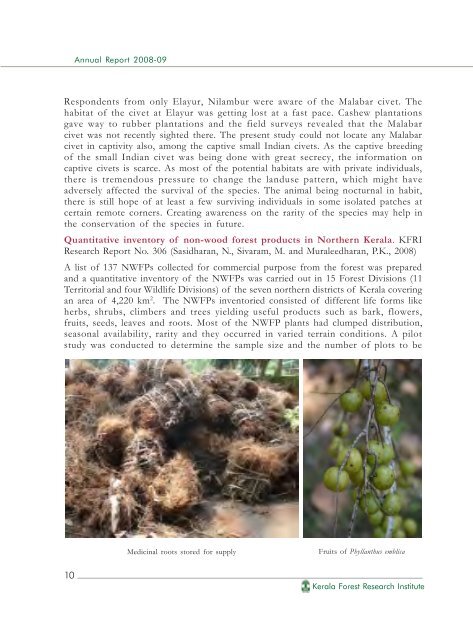2008-'09 - Kerala Forest Research Institute
2008-'09 - Kerala Forest Research Institute
2008-'09 - Kerala Forest Research Institute
Create successful ePaper yourself
Turn your PDF publications into a flip-book with our unique Google optimized e-Paper software.
Annual Report <strong>2008</strong>-09<br />
Respondents from only Elayur, Nilambur were aware of the Malabar civet. The<br />
habitat of the civet at Elayur was getting lost at a fast pace. Cashew plantations<br />
gave way to rubber plantations and the field surveys revealed that the Malabar<br />
civet was not recently sighted there. The present study could not locate any Malabar<br />
civet in captivity also, among the captive small Indian civets. As the captive breeding<br />
of the small Indian civet was being done with great secrecy, the information on<br />
captive civets is scarce. As most of the potential habitats are with private individuals,<br />
there is tremendous pressure to change the landuse pattern, which might have<br />
adversely affected the survival of the species. The animal being nocturnal in habit,<br />
there is still hope of at least a few surviving individuals in some isolated patches at<br />
certain remote corners. Creating awareness on the rarity of the species may help in<br />
the conservation of the species in future.<br />
Quantitative inventory of non-wood forest products in Northern <strong>Kerala</strong>. KFRI<br />
<strong>Research</strong> Report No. 306 (Sasidharan, N., Sivaram, M. and Muraleedharan, P.K., <strong>2008</strong>)<br />
A list of 137 NWFPs collected for commercial purpose from the forest was prepared<br />
and a quantitative inventory of the NWFPs was carried out in 15 <strong>Forest</strong> Divisions (11<br />
Territorial and four Wildlife Divisions) of the seven northern districts of <strong>Kerala</strong> covering<br />
an area of 4,220 km 2 . The NWFPs inventoried consisted of different life forms like<br />
herbs, shrubs, climbers and trees yielding useful products such as bark, flowers,<br />
fruits, seeds, leaves and roots. Most of the NWFP plants had clumped distribution,<br />
seasonal availability, rarity and they occurred in varied terrain conditions. A pilot<br />
study was conducted to determine the sample size and the number of plots to be<br />
Medicinal roots stored for supply<br />
Fruits of Phyllanthus emblica<br />
10<br />
<strong>Kerala</strong> <strong>Forest</strong> <strong>Research</strong> <strong>Institute</strong>

















